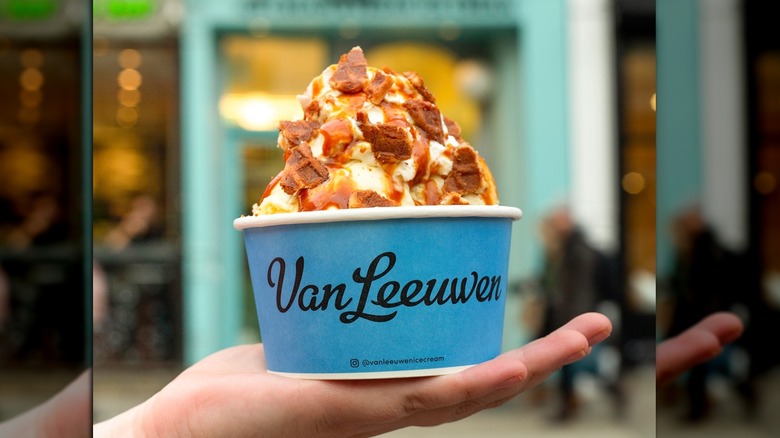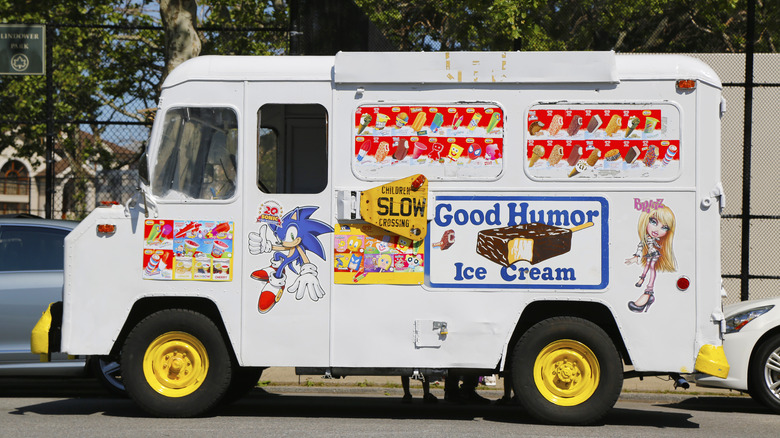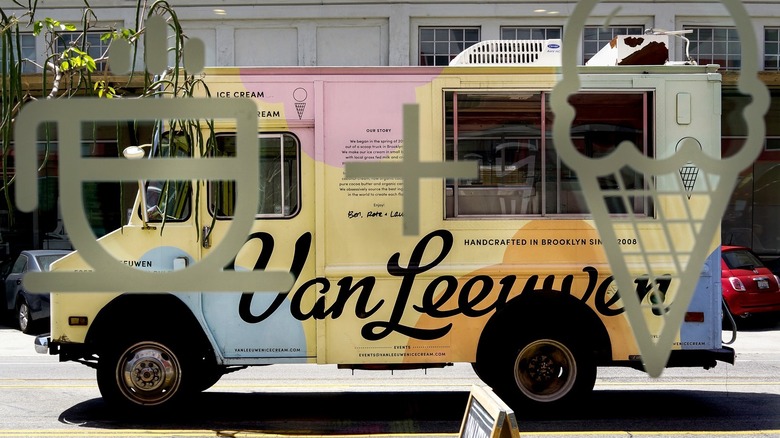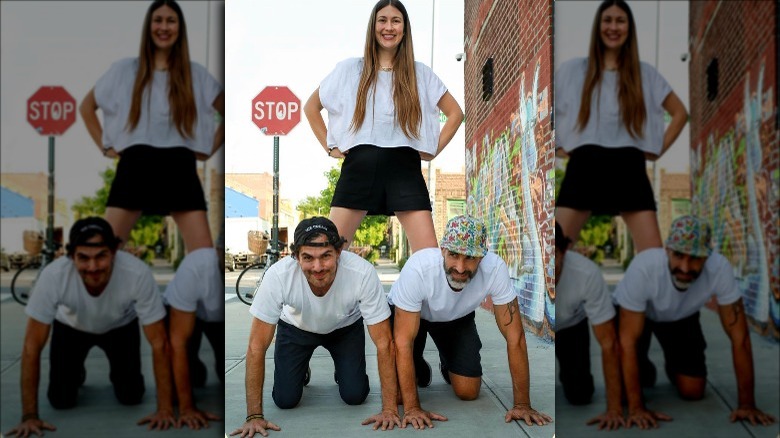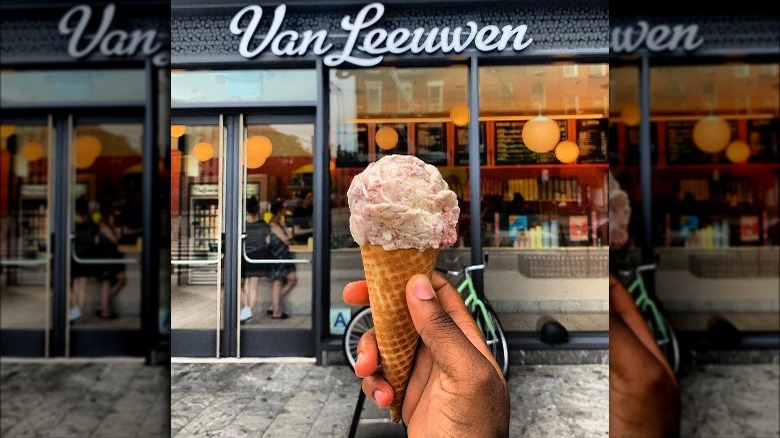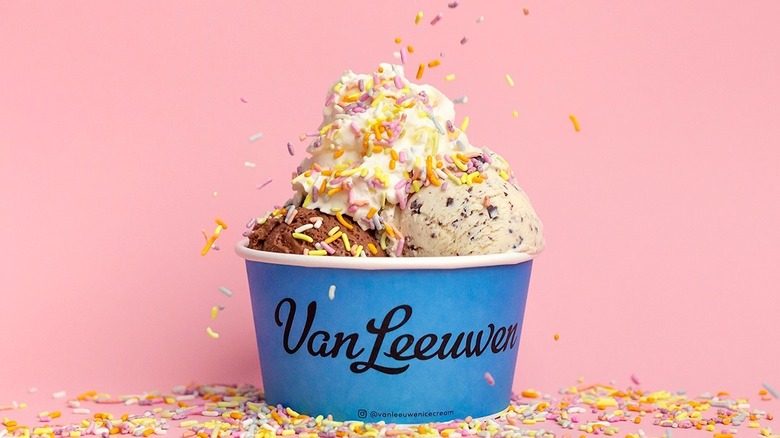The Untold Truth Of Van Leeuwen
Whether it's summertime or any time of the year, for that matter, New Yorkers and a growing number of other Americans think of Van Leeuwen when they think of ice cream. Not just ice cream, either. Van Leeuwen carries about as much non-dairy stuff in its scoop shops as ice cream, according to FoodNavigator-USA.
Van Leeuwen's product page lists the basics — vanilla, chocolate, strawberry — in addition to more unique ice cream flavors such as honeycomb, Earl Grey tea, and Japanese yam & yuzu swirl. For dairy-free ice cream lovers, the company makes cashew milk rocky road, oat milk brownie sundae raspberry swirl, and 20 other flavors listed on its vegan webpage. How good is Van Leeuwen vegan "ice cream?" Kid taste testers at The Beet thought it was so good, they couldn't tell it wasn't real ice cream. Van Leeuwen sells not-quite-a-pint (14 ounces) of dairy or nondairy for $12 ... so it should be good.
Van Leeuwen started selling its ice cream out of a truck in SoHo in 2008. Now, it offers nationwide shipping and supplies 3,000 grocery stores, according to FoodNavigator-USA. That's some pretty cool growth, one scoop at a time. The FAQ page on the company website explains that "Van Leeuwen," pronounced "van," "lou," "inn," is not a Dutch company but rather is the brainchild of Australian Laura O'Neill and American brothers Ben and Pete Van Leeuwen, whose father is Dutch.
The Van Leeuwen concept came out of a Good Humor truck
Ben Van Leeuwen was an entrepreneurial kid. At the age of 11 or 12, he made $80 upselling fake Oakley sunglasses in his Connecticut hometown after purchasing them in Manhattan's Chinatown (via Creator Lab). When he was 17, Ben answered a newspaper ad calling for Good Humor ice cream truck drivers. Shades of his 12-year-old self, he proceeded to sell 15-cent ice cream sticks for $1.50 in affluent Greenwich, Connecticut. He drove a Good Humor truck again the following summer, working seven days a week and 12 hours a day, and saved $40,000 by the end of the gig!
With all that money, Ben packed his bags and flew to Europe. He explored Italy's culinary scene, finding delicious dishes made with simple and fresh ingredients. The experience led him to think about the concept of artisanal. "If you go to India, and Sri Lanka, and Japan, these foods that we consider fancy artisanal foods here, is just the way they eat there," he told Creator Lab. "In Sri Lanka, you grind your own coconut pulp to make coconut milk from scratch when you're making a curry, which here would be only at the fanciest Indian restaurant in all of New York City."
Ben wanted to bring "artisanal" to ice cream — to make a product that only used fresh, basic pantry ingredients. Inspired by his Good Humor days, he decided to sell his ice cream out of a truck.
Van Leeuwen bought ice cream trucks off eBay
Ben Van Leeuwen started his ice cream business venture in 2008, one day after marrying his business partner, Laura O'Neill. (The couple separated romantically in 2012 but continued as business partners, according to Fast Company.) "Ben was aware that while New York didn't face a shortage of ice cream trucks, none were serving anything that was as simple as what came from a home pantry," O'Neill wrote in the recipe book "Van Leeuwen Artisan Ice Cream." They had cemented their business idea. Then came the challenging part: raising funds to kickstart their business.
To make ends meet, the Van Leeuwen co-founders shared an apartment in Greenpoint, Brooklyn and worked odd jobs to support themselves, O'Neill wrote. They raised $70,000 from friends and family, and they used the money to buy two decommissioned postal trucks off eBay. They had the trucks retrofitted with freezers, sliding service windows, and everything else needed to convert them into ice cream trucks. They were painted a buttery yellow, something that O'Neill saw in a vintage General Motors catalog. "We wanted the trucks to have an old-time and a classic look that would continue to look fresh as time went on," she wrote in the recipe book.
Van Leeuwen started with real ingredients in the founders' home kitchen
The most important thing the Van Leeuwen ice cream trucks needed, of course, was ice cream. Ben Van Leeuwen used a recipe from chef Thomas Keller's book "Bouchon" to make a vanilla ice cream — the Van Leeuwen team's very first batch, according to Scope magazine. To his surprise, Ben had just made the most delicious ice cream he had ever tasted. "I was like, 'Oh my God, this is incredible — homemade ice cream is so good,'" Ben told Scope.
Van Leeuwen made — and still makes — ice cream with fresh milk, fresh cream, sugar, and egg yolks. In fact, its product must be labeled "French ice cream" because of the egg yolks, as explained on the company's FAQ page. "Many other super premiums use this stuff, but they supplement it with dry or condensed milk, more sugar, and sometimes corn syrup, whey protein and stabilizers. All of this stuff thickens the product," Ben Van Leeuwen told Gothamist. Instead of using stabilizers, which lower cost but compromise taste, Van Leeuwen decided it would make ice cream the old-fashioned way, with extra egg yolks and more butter fat, as they explained in "Van Leeuwen Artisan Ice Cream." Van Leeuwen isn't trying to be a food for the grocer's "healthy" aisle. "If you want to be really healthy, just eat less ice cream," Ben told FoodNavigator-USA. "Or eat lentil soup."
Van Leeuwen became a $1 million company in its second year
Van Leeuwen beat the odds. According to the Bureau of Labor Statistics, 20% of the businesses fail in their first two years (via Investopedia). Ten years in, the failure rate is 65%. On the very first day in the ice cream truck, the Van Leeuwen brothers found a pretty, cobblestoned spot in SoHo, sold more than 500 scoops of ice cream, and made $2,000 (via Creator Lab). By the end of that first year, they made more than $400,000. The following year, they broke $1 million (via CNBC). After 10 years — again, by the time most businesses have failed — Van Leeuwen reached $20 million in annual earnings.
By 2016, the company was focusing on wholesaling to supermarkets. "I think generally that history's proven that wholesale is the better business," Ben Van Leeuwen told The Counter. "Häagen-Dazs, Ben & Jerry's, Ciao Bella, Talenti — none of them have much retail presence." This doesn't mean Van Leeuwen backed away from retail scoop shops. Far from it. With plans to increase production capacity, open more shops, and experiment with new flavors, the company finally tapped outside investors (unless you count the family and friends who chipped in for start-up costs). Van Leeuwen got a first round of funding in 2018 to aggressively expand its New York storefront presence. In 2020, the ice cream company raised another $18.7 million (via Eater New York).
Van Leeuwen ice creams are made in Greenpoint, Brooklyn
In 2016, according to Dairy Foods, Van Leeuwen moved from its first, 800-square-foot ice cream plant in Greenpoint to another location in the same neighborhood. In the new, 5,000-square-foot space, Van Leeuwen could make 500 gallons of ice cream a day, with the help of a 200-gallon pasteurizer, a semi-automatic pint (okay, 14-ounce) filler, and a freezer more than half the size of the original facility.
Van Leeuwen is able to make its own cashew milk in the expanded facility, for some of its vegan products. As with all of its products, Van Leeuwen spares no expense with its vegan ingredients. The cashews are from Africa, the coconut oil comes from the Philippines, and the cocoa butter is sourced from Ecuador.
Van Leeuwen has always been willing to scour the earth for ingredients. The chocolate is Michel Cluizel from France (via SinglePlatform). Vanilla pods come from Papua New Guinea, the ginger is from Fiji, and — more locally — red currants originated in the Hudson Valley. All the ice creams Van Leeuwen makes in its factory can be made at home — hence the cookbook. After all, Ben and Pete Van Leeuwen, and Laura O'Neill first made them in a small Greenpoint apartment. Just realize, if you try to make Van Leeuwen ice cream at home, it's okay to pick up the pistachios at your neighborhood grocery store rather than the slopes of Mount Etna.
